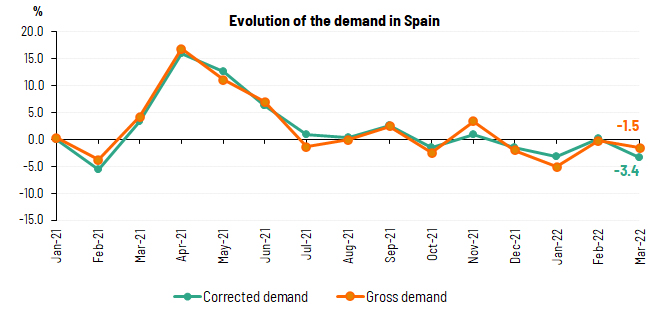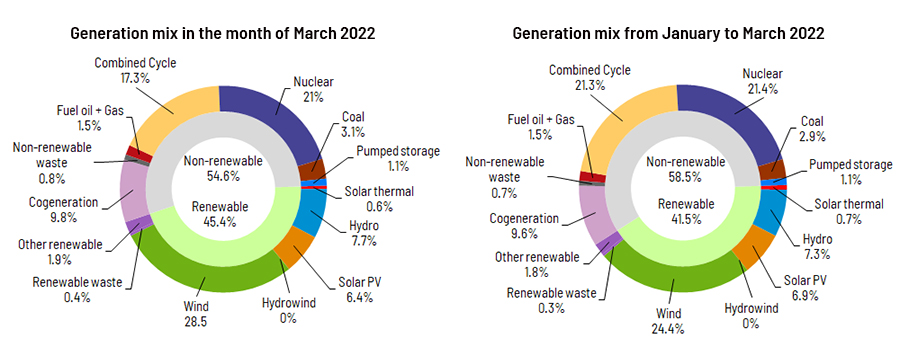We are a global operator of essential infrastructure
- Wind power was the main generation technology with more than a 28% share in the national generation mix.
- 45.4% of monthly generation came from renewable sources and 67% was obtained using zero-carbon energy technologies.
- Electricity demand increased by 7.6% in the Balearic Islands and 12.3% in the Canary Islands compared to March 2021.
National electricity demand in March is estimated at 21,487 GWh, 1.5% lower than that recorded in the same month in 2021. After having factored in the influence of seasonal and working patterns, national demand registered a fall of 3.4%.

In the first three months of 2022, demand is estimated at 64,339 GWh, 2.4% lower than in the same period in 2021. Once again, after having factored in the influence of seasonal and working patterns, the demand is 2.3% lower than in the previous year.
In the month of March, and according to data estimated at the time of this press release, generation from renewable energy sources accounted for 45.4% of generation and 67% of electricity production was obtained using zero-carbon energy technologies.
Wind power generation in March reached 6,479 GWh, a value that is 15.6% higher than in the same month of 2021, and accounted for 28.5% of the generation mix nationwide, ranking it in first place in terms of electricity production in Spain. It was followed by nuclear, with 21%, and combined cycle, which generated 17.3% of the total mix nationwide.

Demand for electrical energy in the peninsular electricity system fell 2.1%
Demand for electrical energy in the mainland electricity system in March is estimated at 20,292 GWh, down 2.1% on the figure registered in March 2021. After having factored in the influence of seasonal and working patterns, demand has decreased by 4%.
In the first three months of 2022, electricity demand on the Spanish mainland is estimated at 60,856 GWh, 2.9% less than in 2021. In this case, after having factored in the influence of seasonal and working patterns, the figure is 2.8% lower than that recorded in the same period last year.
In the month of March, and according to data estimated at the time of this press release, 47.1% of the generation on the Spanish mainland came from renewable sources and 70% was obtained using zero-carbon energy technologies. Wind energy accounted for 6,369 GWh and contributed 29.5% to the electricity generation mix, making it the leading technology, ahead of nuclear, which accounted for 22.1% of the total. Combined cycle (15.3%), cogeneration (10.3%) and hydro (8.1%) complete the ranking of the five technologies that generated the most this month.
Demand for electricity in March increased 7.6% in the Balearic Islands and grew 12.3% in the Canary Islands
In the Balearic Islands, the demand for electricity in March is estimated at 441,131 MWh, a value that is 7.6% higher than that recorded in the same month last year. After having factored in the influence of seasonal and working patterns, the figure is 4.8% up on that recorded in March 2021. In the first three months of 2022, gross demand on the Balearic Islands is estimated at 1,302,680 MWh, a value that represents an increase of 4.8% compared to the same period in 2021.
In terms of overall generation, combined cycle, with 81.6% of the energy produced in the Balearic Islands, was the leading technology in the archipelago in March. Thus, renewable energy obtained using zero-carbon energy technologies generated in the Balearic Islands accounted for 5.9% of the total. In addition, during this month the submarine link between the mainland and Majorca contributed to covering 6.8% of the electricity demand in the Balearic Islands.
Regarding the Canary Islands, electricity demand is estimated at 719,028 MWh, up 12.3% on that recorded in March 2021. After having factored in the influence of seasonal and working patterns, demand increased by 12.4% compared to the previous year.
In the first three months of 2022, demand on the Canary Islands, in gross terms, is estimated at 2,081,747 MWh, 11.6% higher than in the same period in 2021.
Regarding electricity generation in the Canary Islands, combined cycle, with 42.5% of the total, was also the leading technology in March, while renewables and zero-carbon energy technologies accounted for 19% of production, with wind power generation being 29% higher than in March 2021.
Consult our Daily Balance Report for more information on the National, Peninsular, Balearic Islands and Canary Islands electricity systems as at the close of March.














